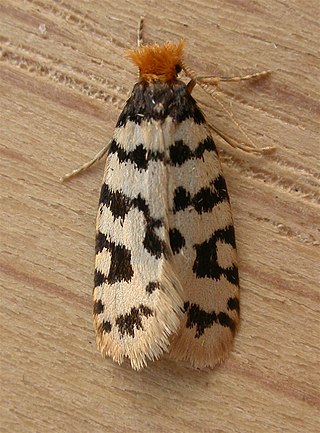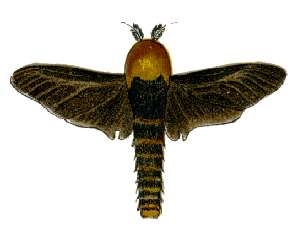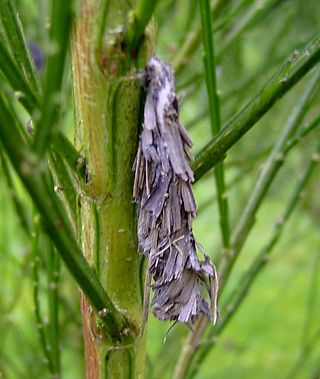
The Psychidae are a family of the Lepidoptera. The bagworm family is fairly small, with about 1,350 species described. Bagworm species are found globally, with some, such as the snailcase bagworm, in modern times settling continents where they are not native.

The Phoridae are a family of small, hump-backed flies resembling fruit flies. Phorid flies can often be identified by their escape habit of running rapidly across a surface rather than taking to the wing. This behaviour is a source of one of their alternate names, scuttle fly. Another vernacular name, coffin fly, refers to Conicera tibialis. About 4,000 species are known in 230 genera. The most well-known species is cosmopolitan Megaselia scalaris. At 0.4 mm in length, the world's smallest fly is the phorid Euryplatea nanaknihali.

Cecidomyiidae is a family of flies known as gall midges or gall gnats. As the name implies, the larvae of most gall midges feed within plant tissue, creating abnormal plant growths called galls. Cecidomyiidae are very fragile small insects usually only 2–3 mm (0.079–0.118 in) in length; many are less than 1 mm (0.039 in) long. They are characterised by hairy wings, unusual in the order Diptera, and have long antennae. Some Cecidomyiids are also known for the strange phenomenon of paedogenesis in which the larval stage reproduces without maturing first. In some species, the daughter larvae consume the mother, while in others, reproduction occurs later on in the egg or pupa.

Insect wings are adult outgrowths of the insect exoskeleton that enable insects to fly. They are found on the second and third thoracic segments, and the two pairs are often referred to as the forewings and hindwings, respectively, though a few insects lack hindwings, even rudiments. The wings are strengthened by a number of longitudinal veins, which often have cross-connections that form closed "cells" in the membrane. The patterns resulting from the fusion and cross-connection of the wing veins are often diagnostic for different evolutionary lineages and can be used for identification to the family or even genus level in many orders of insects.

The Ecnomidae are a family of caddisflies comprising 9 genera with a total of 375 species.

Spodoptera littoralis, also referred to as the African cotton leafworm or Egyptian cotton leafworm or Mediterranean brocade, is a species of moth in the family Noctuidae. S. littoralis is found widely in Africa, Mediterranean Europe and Middle Eastern countries. It is a highly polyphagous organism that is a pest of many cultivated plants and crops. As a result, this species was assigned the label of A2 quarantine pest by the EPPO and was cautioned as a highly invasive species in the United States. The devastating impacts caused by these pests have led to the development of both biological and chemical control methods. This moth is often confused with Spodoptera litura.

Discophlebia catocalina, the yellow-tailed stub moth is an Australian moth species found in the south-eastern quartile of Australia. It is classified within the Oenosandridae moth family in the Noctuoidea Superfamily, the largest superfamily of the Order Lepidoptera. It is visually recognised by its characteristic pointed yellow tail and is a medium-sized moth species with a wingspan range of 40mm-60mm depending on gender. Discophlebia Catocalina have evolved to feed on various species of eucalypt.

Abantiades latipennis, known as the Pindi moth, is a species of moth in the family Hepialidae. It may also be referred to as a swift moth or a ghost moth, as this is a common name associated with Hepialidae. Endemic to Australia and identified in 1932, it is most populous in temperate rainforest where eucalypti are prevalent, as the larvae feed primarily on the roots of these trees. Females lay eggs during flight in a scattering fashion. The larvae live for over eighteen months underground, while adult moths survive for approximately one week, as they have no mouthparts with which to feed. The moths are preyed upon by a number of predators, including bats and owls. Brown in colour overall, males are paler and the identifying silver bars of the male's wings are more prominent than those of the female's, with dark margins. Male adults are generally smaller.

Pyrrhochalcia is a genus of butterflies in the family Hesperiidae. It contains only one species, Pyrrhochalcia iphis, the African giant skipper, which is found in Guinea, Sierra Leone, Liberia, Ivory Coast, Ghana, Togo, Nigeria, Cameroon, Gabon, the Republic of the Congo and Angola. It was first described by Dru Drury in 1773.

The external morphology of Lepidoptera is the physiological structure of the bodies of insects belonging to the order Lepidoptera, also known as butterflies and moths. Lepidoptera are distinguished from other orders by the presence of scales on the external parts of the body and appendages, especially the wings. Butterflies and moths vary in size from microlepidoptera only a few millimetres long, to a wingspan of many inches such as the Atlas moth. Comprising over 160,000 described species, the Lepidoptera possess variations of the basic body structure which has evolved to gain advantages in adaptation and distribution.

Insect morphology is the study and description of the physical form of insects. The terminology used to describe insects is similar to that used for other arthropods due to their shared evolutionary history. Three physical features separate insects from other arthropods: they have a body divided into three regions, three pairs of legs, and mouthparts located outside of the head capsule. This position of the mouthparts divides them from their closest relatives, the non-insect hexapods, which include Protura, Diplura, and Collembola.

Dingana alaedeus, the Wakkerstroom widow, is a butterfly of the family Nymphalidae. It is only known from high altitude grassland at about 2,000 meters. It has a short flying period in summer. The specific name means “god of the wing” in Latin.

The Erebidae are a family of moths in the superfamily Noctuoidea. The family is among the largest families of moths by species count and contains a wide variety of well-known macromoth groups. The family includes the underwings (Catocala); litter moths (Herminiinae); tiger, lichen, and wasp moths (Arctiinae); tussock moths (Lymantriinae), including the arctic woolly bear moth ; fruit-piercing moths ; micronoctuoid moths (Micronoctuini); snout moths (Hypeninae); and zales, though many of these common names can also refer to moths outside the Erebidae. Some of the erebid moths are called owlets.

Saunders' case moth or the large bagworm is a moth of the Psychidae family. It is known from the eastern half of Australia, including Tasmania.

Pachythelia villosella is a moth of the Psychidae family. It is found in Europe.

Acanthopsyche atra, the dusky sweep, is a moth of the family Psychidae. The habitat consists of heath and moorland.

Acanthopsyche is a genus of moths in the Psychidae family. The genus was named by the Dutch entomologist Franciscus J.M. Heylaerts.

Ichneutica paraxysta is a moth of the family Noctuidae. It is endemic to New Zealand. This species is very similar in appearance to its close relative I. acontistis but as the range of the two species do not overlap this is unlikely to cause confusion. I. paraxysta is only found in the North Island at the subalpine zones in the Mount Taranaki region and at Mount Ruapehu. It prefers tussock grassland and shrubland habitat. The life history of this species is unknown as are the host species of its larvae however it has been hypothesised that the larval host plants are species in the genera of Poa and Festuca.

Pteroma plagiophleps is a moth of the family Psychidae first described by George Hampson in 1892. It is found in India, Bangladesh, Sri Lanka, and Indonesia.
Mahasena corbetti, the coconut case caterpillar, is a polyphagous species of bagworm. This species is classified as leaf-eating pest caterpillars that produce tough silk out of their bags from dried foliage. Currently, M. corbetti is considered a 'pest of quarantine importance' in multiple countries and is included on the list of dangerous pests in the Malaysian plant quarantine act.



















